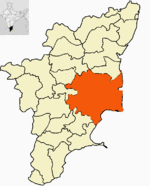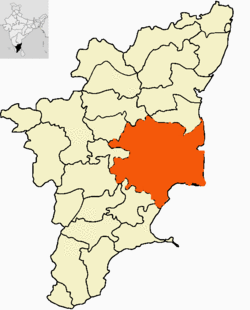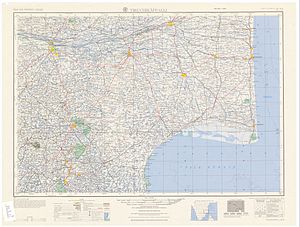- Chola Nadu
-
Chola Nadu (சோழநாடு)
Cauvery Delta, Cholamandalam
Rice Bowl of Tamil Nadu — region — Coordinates Country India State Tamil Nadu, Puducherry District(s) Ariyalur ,
Karaikal (Puducherry),
Nagapattinam,
Perambalur,
Pudukkottai,
Thanjavur,
Tiruchirapalli,
TiruvarurDistrict(s) 8 Largest city Tiruchirapalli Population
• Density
10,191,035 (2001[update])
• 413 /km2 (1,070 /sq mi)
Time zone IST (UTC+05:30) Area 24,667 square kilometres (9,524 sq mi) Codes-
• Telephone • +04362
Chola Nadu (Tamil: சோழநாடு) is a region of Tamil Nadu state in southern India. It encompasses the lower reaches of the Kaveri River and its delta, and formed the cultural homeland and political base of the Chola Dynasty which ruled most of South India and parts of Sri Lanka and South-East Asia between the 9th and 13th centuries AD. Uraiyur served as the early Chola capital, then medieval Cholas shifted to Thanjavur and later cholas king Rajendra Chola I moved the capital to Gangaikonda Cholapuram in the 11th century.
The boundaries of the region roughly correlates with those of the British India districts of Tanjore and Trichinopoly. Culturally, the region also includes Pudukkottai District, Ariyalur District, Perambalur District and the territory of Karaikal.[1]
Contents
Location
The Cholanadu region covers Central Tamil Nadu and East-Central Tamil Nadu. The region is sandwiched between the historical regions of Tondai Nadu in the north, the Madurai region in the south and Kongunadu in the west and roughly extends from Chidambaram in north to the southern frontier of the erstwhile Pudukkottai kingdom and from Tiruchirapalli in the west to the Bay of Bengal in the east.
According to the Gazetteer of the Trichinopoly District, Vol II, 1931, p 67, "the traditional meeting place of the three Tamil kingdoms was the temple of Cellānti Amman on the banks of the Kāvēri, twelve miles west of Kulittalai and three miles below the junction of the Amarāvati and the Kāvēri. The temple was the common place of worship for the kings of the three Tamil dynasties; a bund which runs to the south of the river marks the boundary between the Cōla and the Pāntya territories, and the Karaipōttanār on the opposite bank of the river was the boundary between the Cōla and the Cēra kingdoms".[2]
History
The history of the region begins with the rise of the Early Chola kingdom in the 4th century BC. The Early Cholas ruled from the town of Uraiyur near Tiruchirapalli and their kingdom comprised the whole of the present-day Cauvery Delta. Flourishing centres of Roman trade have been excavated at Poompuhar stand testimony to a prosperous civilization.
Culture
The Chola Nadu region is renowned as a hunb of Tamil culture and civilization. The region has been continuously inhabited since the 1st millennium BC. Arts, crafts and music flourished under the Cholas whose reign is considered to be the golden age in the history of Tamil Nadu. During the hegemony of the Vijayanagar Empire and its successors, the zThanjavur Nayak kingdom, there were frequent migrations of priests, administrators, soldiers and artists from the Telugu and Kannada districts of the north who brought in their traditions, art and dance forms. Despite its rise and initial success in the northern part of Karnataka, Carnatic music actually flourished in the Cauvery Delta. The three great Carnatic music composers, Tyagaraja, Syama Sastri and Muthuswami Dikshitar who form the Great Trinity of Carnatic music hailed from the Chola Nadu region as also the music composers Muthu Thandavar, Arunachala Kavi and Marimutthu Pillai who form the Tamil Trinity of Carnatic music.
Apart from music, dance and drama have also flourished in the Cauvery Delta. The Bhagavathar Melas, a series of dance-dramas, written almost entirely in Telugu, were introduced by migrants who sought refuge in the town of Melattur following the collapse of the Vijayanagar kingdom at the Battle of Talikota.
Bharatanatyam, a popular dance form native to Tamil Nadu, had its origin in the dance of sadir which was practised in the temples of Chola Nadu by ritual temple dances or devadasis. Patronized and financed by dharmakarthas and rich mirasidars, sadir was popular until the early years of the 20th century when a strong voiced campaign resulted in the devadasi practised being outlawed. Sadir has, since, purged itself of its erotic symbolism and movements and gradually evolved into the commoners' dance Bharathanatyam.
Demographics
The Chola Nadu region had a population of over 10 million with a density of above 400 persons per square kilometre in 2001. Due to fertile soil and favourable climate, the region has been the most densely populated in the Tamil country since ancient times.
More than 90 percent of the population speak Tamil. There is a significant Telugu speaking minority, who had descended from migrants who had mostly moved in during the Vijayanagar and Thanjavur Nayak periods. There are smaller populations speaking Kannada, Saurashtrian and Urdu. There are also a considerable body of Marathi speaking people who are mostly present in the urban areas of Thanjavur district and the city of Tiruchirappalli.
Important Personalities
The Chola Nadu region has produced a umber of noteworthy personalties in the fields of arts, science, film and politics. Long recognized as a hub of Carnatic music, the region is home to most of India's renowned Carnatic musicians. There have also been important individuals in the field of politics. In British times, civil servants and lawyers from Chola Nadu like Sir T. Madhava Rao, Sir A. Seshayya Sastri, Sir Mohammad Usman, Sir A. T. Panneerselvam, Sir T. Muthuswamy Iyer, Sir P. S. Sivaswami Iyer, T. Ananda Rao, V. S. Srinivasa Sastri, V. P. Madhava Rao and R. Raghunatha Rao dominated the bureaucracy. The maternal ancestors of Sir C. P. Ramaswami Iyer hailed from Kumbakonam. Tamil writers V. V. S. Aiyar and Kalki Krishnamurthy, journalists Kalki Sadasivam, G. A. Natesan and Kasturi Ranga Iyengar, Indian independence activist G. Subramania Iyer who founder The Hindu, politicians M. R. Sethuratnam Iyer and S. Muthiah Mudaliar and Indian media mogul S. S. Vasan were some prominent individuals from the Chola Nadu region. Yesteryear film actors Sivaji Ganesan, M. K. Thyagaraja Bhagavathar, Gemini Ganesan and T. R. Rajakumari, Indian scientist and Nobel Prize winner Sir C. V. Raman and mathematician Srinivasa Ramanujan were other important people from the region.
Recent time politicians include the former Chief Minister of Tamil Nadu M. Karunanidhi, former President of India R. Venkataraman, late Tamil Nadu Congress leader G. K. Moopanaar and Union Minister Mani Shankar Aiyar. Film personalities such as directors K. Balachander, S. Shankar and Mani Ratnam and actors Arvind Swamy and Hema Malini hail from the region.
See also
Notes
References
- "History of the Chola Empire or Chola-mandalam". Louis Gerber. http://www.cosmopolis.ch/english/cosmo40/chola_mandalam_empire.htm.
- S. Gajrani (2004). History, Religion and culture of India. Gyan Publishing House. pp. 5. ISBN ISBN 8182050596, ISBN 9788182050594.
- Eugene F. Irschick (1994). DIalogue and history: constructing South India, 1795-1895. University of california Press. pp. 105.
Further reading
- R. Krishnamurthy (1979). The Saints of the Cauvery Delta. Delhi: Concept Publishing Company.
- M. S. Ramesh (2000). 108 Vaishnavite Divya Desams: Divya desams in Chola Nadu. Thirumala-Thirupathi Devasthanams.
Chola Nadu State 
Districts Ariyalur · Karaikal · Nagapattinam · Perambalur · Pudukkottai · Thanjavur · Tiruchirapalli · TiruvarurLargest City 100,000+ Municipalities Culture Aadi Perukku · Bharatanatyam · Carnatic Music · Poi-kāl kuthirai · Tanjore painting · Tanjore doll · Tyagaraja AradhanaRivers Languages Categories:- Regions of Tamil Nadu
-
Wikimedia Foundation. 2010.


